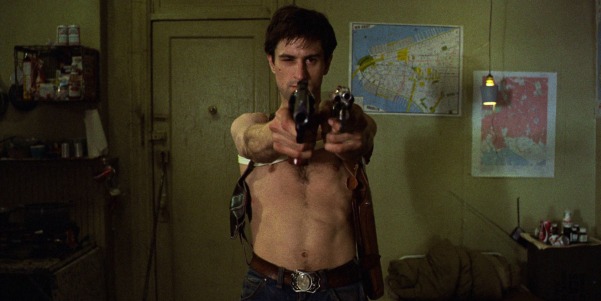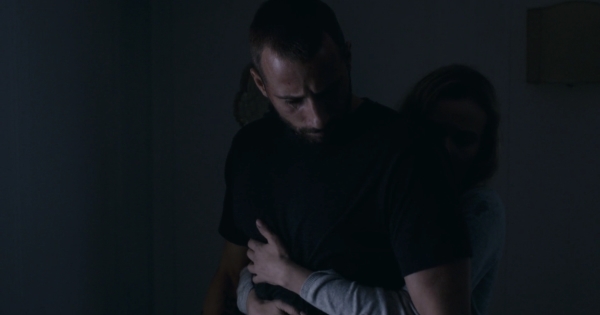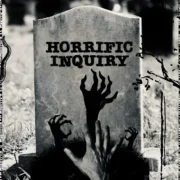Enter The Soldier’s Mind: Visions Of PTSD In TAXI DRIVER & DISORDER

Chris is a B.A.H. graduate with a concentration in pre-19th…
Post-traumatic stress disorder – abbreviated as PTSD – has been a subject in film as far back as the 1946 John Huston documentary Let There Be Light. Since the Invasion of Iraq, it’s become a prevalent concept.
One of the most original to have been made is Martin Scorsese‘s 1976 classic Taxi Driver. It’s a tale of the disillusioned journey taken through New York City by Vietnam vet Travis Bickle, played unforgettably by Robert De Niro. Written by Paul Schrader, Taxi Driver examines the ideas of loneliness and social isolation, ultimately depicted as leading to horrific violence.
Four decades later, writer-director Alice Winocour explores similar territory in her film Disorder. Her focus is on a contemporary character with a less clear military history as his predecessor: Vincent, played by Matthias Schoenaerts, has a case of post-traumatic stress disorder that the viewer experiences visually and aurally alongside him.
Both films are thematically close, especially considering the violence involved, although Scorsese’s film is decidedly more bloody. What makes them wonderfully different is how both directors present the material in a way that speaks to the generations in which they were made.
Whereas Scorsese and Schrader focused on how the Vietnam War affected the morality of its veterans, Winocour encompasses the post-Invasion of Iraq sentiments of many young men whose entire lives are forever shaped by their military service both economically and psychologically.
A Narrative of Mental Illness
De Niro’s Travis Bickle is iconic because of his famously improvised “Are you talkin’ to me?” sequence. In this scene Bickle confronts the mirror brandishing a homemade contraption to propel a gun out of his sleeve. On one hand, if you take it at face value, there’s a machismo to the way he plays the lines, like a man pumping up his masculinity.
On the other hand, we’re witnessing a deranged man whose psychological foothold is slipping. Bickle is actually pumping himself up to do what it is he wants to do: be violent. Schrader’s screenplay asks several questions about the nature of our morality, specifically about the fringes where there exist grey areas such as whether violence is acceptable in certain situations.
Although there is imagery, mostly due to how Scorsese directs the picture, the narrative power of the screenplay and the well-written character of Travis are what drives the exploration of mental illness here.
For instance, Travis suffers from PTSD because of his service in Vietnam, so back home in New York City he’s searching for a way to alleviate the longing for human connection. He’s also trying desperately to keep his mind off killing. We witness his unnerving journey in all its brutal glory.
The awkward struggle of Travis trying to date a woman is the first sign of his antisocial behaviour. He takes her to a porno theatre, as if it were completely normal, and this is the beginning of his downward spiral into murky morality.

The biggest question comes near the end after Travis lets loose a chaotic tornado of gun-play: can we accept the double-edged sword that Bickle at once killed bad men who were all complicit in the prostitution of a minor, and also just wanted to kill? Their question puts us between a rock and a hard place.
Sure, Harvey Keitel’s character and the others killed during the finale are despicable human beings. Yet Travis wanted to kill a politician earlier. If he had had his way it’s likely he’d have been in jail, unable to kill the pimp and the others. So, essentially, his killing of these low life criminals is merely a byproduct of an earlier inability to act out his violent urges.
After many soldiers committed atrocities while serving in Vietnam, evidenced by events such as the My Lai Massacre, they came back home with damaged morals. Their life as a soldier and their other life as a citizen no longer felt divided. Their experiences during wartime imprinted a need for violence on their brain.
Travis is the epitome of post-traumatic stress because of his inability to translate his new violent behaviour into anything other than antisocial behaviour. The problematic element of his character is whether or not you can label him as a hero by the end.
In opposition, the character of Vincent in Disorder is a most certainly a hero, and it is not his violence we examine, but rather the very mental process through which he goes trying to keep himself from succumbing to madness.
The Sights and Sounds of Post-Traumatic Stress
Like Bickle, the main character of Alice Winocour’s Disorder is a soldier named Vincent who is trying to keep his mind occupied. Travis drives a cab and goes to porno theatres, as opposed to Vincent, who is stuck in the life of a soldier who works contract jobs as private security for the rich. He is not necessarily a violent man.
However, in the post-9/11 landscape of how global society sees military service, a man like Vincent is essentially stuck in his position. He suffers from PTSD, but he is only a soldier and seems to have no other skills. Unlike the 1970s when Travis roamed New York City, the economic opportunities aren’t always as easy to come by.
Nowadays you can’t just walk in anywhere off the street and fall backwards into a job. So, Vincent continues working in a relatively dangerous line of work even though the opening scene of the film depicts his fragile mental and physical state. In turn, the work only serves to exacerbate his condition; one represented vividly through imagery and sound.
During some scenes Winocour challenges you for a moment to figure out if what you’re hearing is part of the music, or if it’s an aural representation of Vincent’s PTSD. Such as when he’s first scoping out the party where he’ll be working security and the pounding electronic bass drum briefly seems like it’s emanating from the speakers. In reality, it is Vincent’s heartbeat.

Once he regains composure the sound stops and we’re back amongst the scene’s natural noise. So instead of Winocour relying totally on the quality acting of Matthias Schoenaerts, she involves us totally in the world of Vincent to the point where it feels as if we’re experiencing events directly through him.
In this same scene, as well as others, the shot gets blurred. Our only clarity is Vincent, so that we’re visually experiencing his condition along with the sounds. Later when Vincent and a woman he’s protecting are attacked, the sound and imagery are again presented through his perspective: a car window is suddenly smashed next to his head before we are again immersed in sounds that feel far away and the focused view of Vincent while everything else in frame is dull and blurred.
What’s interesting about this is the fact Winocour takes us into Vincent’s headspace, though also uses the same aural and visual aesthetic throughout in that it isn’t only his PTSD we’re privy to. We generally hear and see everything from his point of view. This strengthens our attachment to the character.
Vincent isn’t isolated and crazy the way Schrader wrote Travis Bickle. Winocour’s depiction of Vincent through aural and visual techniques gives us a direct line to his emotions. Therefore, we become a part of the main story of Maryland. That is to say by the end the viewer is never capable of fully deciding if Vincent is delusional or if he has a grasp on reality.

Similar to the last couple shots of Taxi Driver, right before the end credits roll on Disorder, we witness Vincent in a situation which throws our perception of what has happened before. Although he has successfully saved the woman with whom he was charged to protect, his struggle with PTSD is seemingly never over.
Then if you’re to believe the final shot is an affirmation of his delusion it is almost scary to think back over the events of the film, because while he’s effectively transformed into the hero, able to be a soldier while still on home soil, Vincent is forever trapped in a world defined by his PTSD.
Conclusion
Right down to particular scenes, Taxi Driver and Disorder share the same DNA. There’s no doubt that Scorsese’s film influenced Winocour. Nonetheless, the way they approach the same subjects and represent the various struggles of their central characters is vastly different.
From the start of Taxi Driver we are fully aware of Travis and his slightly warped thought process. Schrader’s screenplay contains a generous heap of inner monologue through voice-over serving as a way of unpacking the PTSD Travis suffered after Vietnam. There’s never any question if he is seeing things.
The intensity of his experience comes through the story itself by taking aim at real, violent consequences of post-traumatic stress. In contrast, Disorder starts us off immediately with a feeling of being in the main character’s skin via sound and imagery converging to represent Vincent and his struggle with the effects of PTSD.
Above all, each film is a product of its time. Travis represents an era in which terrifying violence was coming back home with soldiers no longer able to tell right from wrong. Meanwhile, Vincent acts as a contemporary representation of how many soldiers coming home in the 21st century from war are left to their own devices with serious medical side effects.
Yet despite their striking differences, both films end on a note of ambiguity where the final trajectory of these damaged characters is not readily apparent. We are never given the answers, nor do Scorsese or Winocour pretend to hold them.
What we do get is an in-depth exploration of how the Vietnam War and the post-9/11 military world respectively shaped these two cinematic portrayals of PTSD, as Taxi Driver tackles its issues through narrative and Disorder uses all its aesthetic arsenal to drive the point home.
After comparing these two films and their endings, is there a better tomorrow for either Travis or Vincent? If so, is there any evidence to support that? Or are they both doomed to repeat the cyclical violence of war and forever trapped in the PTSD which plagues them?
Does content like this matter to you?
Become a Member and support film journalism. Unlock access to all of Film Inquiry`s great articles. Join a community of like-minded readers who are passionate about cinema - get access to our private members Network, give back to independent filmmakers, and more.
Chris is a B.A.H. graduate with a concentration in pre-19th century literature from Memorial University of Newfoundland. His short stories have been published in The Cuffer Anthology Volumes VI & VII, as well as upcoming stories in new anthologies from Centum Press (One Hundred Voices & One Hundred Voices Pt. II) and Science Fiction Reader. A short screenplay of his titled "New Woman" is currently being produced, to be shot in 2017; it is a female-led dramatic horror, a period piece set in 1888.













